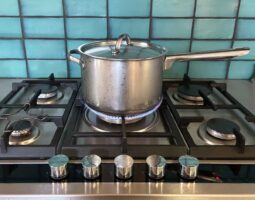The ACT is a leader in Australia – and even the world – in the charge to all-electric living, but new government documents reveal a major hurdle remains the cost getting homes and businesses safely and permanently disconnected from the gas network.
In its Integrated Energy Plan, the proposed electrification pathway that was opened to public consultation at the start of the month, the ACT government notes that the current fee to abolish a gas network connection is around $770-$800 for a home, and around $1,500 for a business.
This is a problem for a couple of reasons. First, it’s a big cost and therefore a major disincentive to go electric – particularly problemative over the first stage of the transition, which the IEP proposes to be primarily consumer-led out to 2030.
The second problem is that there is a cheaper option: gas network disconnection – a temporary measure that turns off the supply to the home at the customer side of the meter and costs around $100 if done at the same time as appliance removal.
This is good for the consumer keen to make a start on their shift to all electric, but far from ideal on most other measures – including that it is not the safest option and also kicks the can down the road on the inevitable cost of doing the job properly in the long term.
“The last step in the transition to an all-electric household or business is to abolish or disconnect a gas connection,” the ACT’s IEP says.
“Temporary gas disconnection is often the preferred option for customers as it is currently more affordable than the cost of abolishment. However, the safest option is to abolish the gas network connection.”
As the IEP explains, this is the safest option because it removes all risks associated with having a pressurised gas pipe on a property, including risk of gas leaks and excavation strikes.
It also involves more work than the disconnection process, such as digging up the connection point to cut the service line from the gas main, evacuating gas and removing the meter safely.
The process requires at least two people onsite, may require traffic management, site restoration works and up to two hours of work, the plan says.
The ACT government notes that, in Victoria, the Australian Energy Regulator has come up with a temporary fix for the problem in that state by introducing a set, low cost for gas connection abolishment – at $220.
This reduces the upfront payment from the disconnecting household and spreads the remaining cost to the network company across all gas users.
“To reduce the price difference between the two disconnection services, and the safety risks it appears to be creating, this final decision retains an upfront cost of $220 for connection abolishment and shares the remainder between all customers,” the AER said of its decision in June.
The decision, the regulator stressed at the time, is “not a change” to the total costs AusNet is allowed to recover for Victorian gas connection abolishment services, but a change to the way in which costs are recovered. It’s also a temporary fix, and not a permanent one.
“Socialising costs in this way helps to address the safety risk of leaving ‘live’ but unused assets in place by removing the incentive for customers seeking to avoid the high cost of permanent abolishment when a connection is no longer required,” said AER chair Clare Savage at the time.
“However, a socialised abolishment cost model is only an interim measure to address this public safety issue.
“Further work is required across the sector to develop a more sustainable solution. In the event that gas demand declines and the number of customers leaving the network increases, there will be upwards pressure on prices for remaining customers.”
For its part, the ACT government says it will work with the AER, Evoenergy and other jurisdictions to investigate options to minimise the safety risks of gas disconnection and to consider the barrier current fees present to electrification, and network planning challenges.
“This work will be prioritised ahead of the AER’s next decision on gas network arrangements for the ACT, which will cover the period 2026-2031,” the IEP says.
See more details about electrification, and stories on how to go electric, in our new sub-site SwitchedOn. It includes articles, interviews, how-to stories and podcasts.










